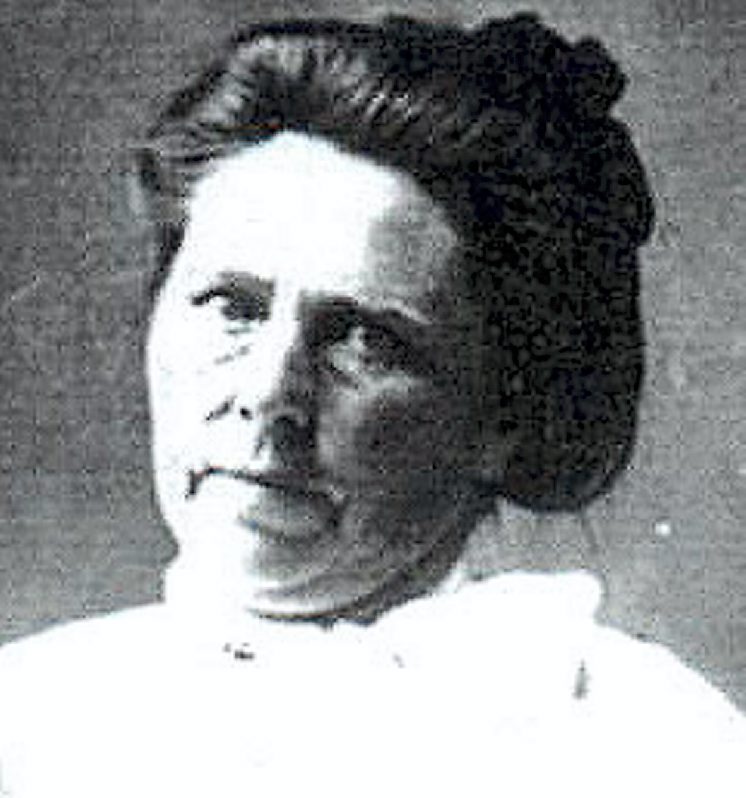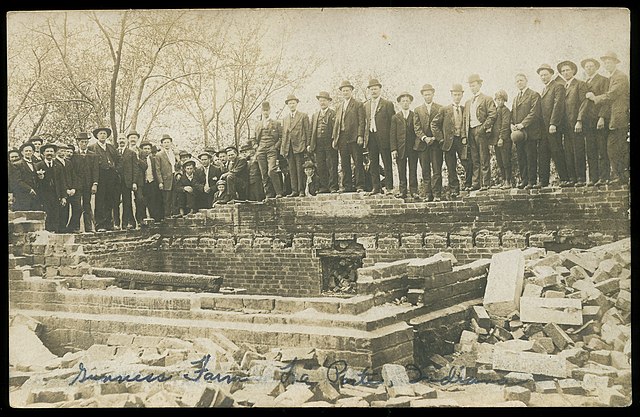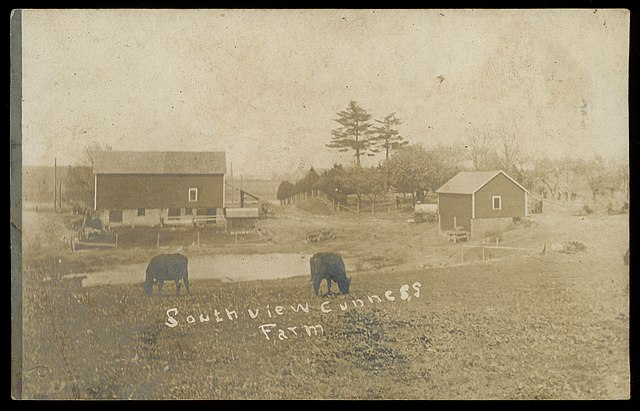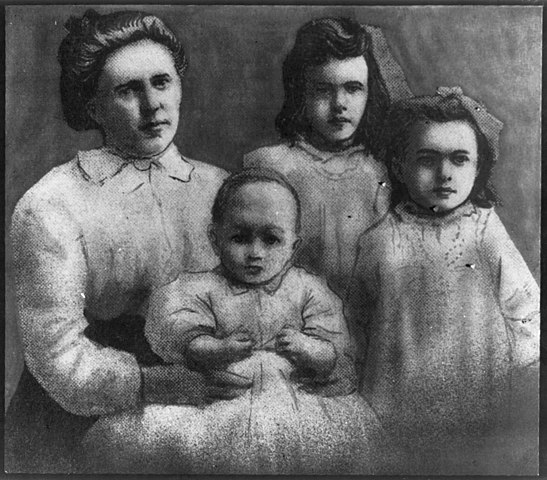On the morning of April 28, 1908, everything changed for the small city of La Porte, Indiana. During the night, a fire erupted at the Gunness homestead and burned the farmhouse to the ground, along with everyone inside it. The charred remains of four people were recovered from the smoldering ruins – one woman and three young children. Clearly, what had happened was that Belle Gunness, the widow who owned the property, had perished trying to save her children. The whole town decried the loss of one of their own, a heroic woman who sacrificed her life for her family.
The police had a more sinister idea in mind. The woman’s body had been found headless so, unsurprisingly, they suspected foul play. They thought that a former farmhand named Ray Lamphere might be worth looking into, fearing that he could have killed Belle Gunness and then staged the fire to hide his murderous deed.
Even so, in the minds of everyone, Belle Gunness was still the victim here, but that image would soon be shattered, as investigators kept digging around the property, looking for her skull. One day, almost a week after the blaze, diggers explored a small mound of fresh earth in the pig pens and uncovered a gunny sack, buried under a layer of trash. Inside the bag – two hands, two feet, and one head. All belonged to the same man and all had been chopped up with an ax. A slow sensation of dread crept up on the investigators, as they realized that dozens of similar mounds were strewn across the pig pens.
They started digging them all up, and each one yielded remains from another victim. The true extent of the horror that went on at that homestead soon became apparent – for years, Belle Gunness had been using her farmhouse as the location where she killed, dismembered, and buried her victims. All of a sudden, nobody was singing her praises anymore, as people saw Belle Gunness for what she truly was – one of the most vicious murderers in the history of the United States.

More details
Belle Gunness in 1904.
Early Years
Belle Gunness was born Brynhild Paulsdatter Størset on November 11, 1859, in the municipality of Selbu, Norway, the daughter of Paul and Berit Størset. Her father worked as a stonemason, and he expected all of his children to pitch in and help keep the family farm going. Therefore, Belle got used to hard work from an early age and, when she got older, she was hired by a wealthy family to work on their farm, as well. Fortunately for Belle, she was a physically strong woman, so she never shied away from manual labor.
Since her early life is poorly documented, it’s a little hard to pinpoint any reason for Belle Gunness’s murderous actions. Her childhood wasn’t exactly a walk in the park, but it wasn’t “Please, sir, I want some more,” either. There is one story, but it remains unverified, which claims that Belle got pregnant when she was 18, and that she attended a dance where she was attacked and kicked in the stomach. The attack caused her to have a miscarriage and, to make matters worse, her assailant got off scot-free because he came from a wealthy and influential family. Soon afterward, karma took matters into its own hands and gave the man stomach cancer, but the whole ordeal left Belle Gunness a different woman. Her friends and family said that, outwardly, her personality and behavior changed drastically, while inwardly, it is possible that she started harboring a vicious resentment towards those around her. As we said, this might be just a story, but it could provide Belle Gunness with a motive for her killings, besides the allure of easy riches.
Either way, a couple of years later, Belle got the opportunity to move to America. Her older sister, Anna, had left years earlier, and she married a man named John Larson in Chicago and started a new life. In 1881, she asked Belle to join her and the 22-year-old woman jumped at the opportunity. Later that same year, Belle Gunness left Norway and made her way to Chicago to live with her sister. There, she discovered a familiar setting, full of the same traditions and culture she had left behind because Anna and her husband lived in a close-knit Scandinavian community.
A short while later, Belle met a man named Mads Sorenson who worked as a night watchman at a department store. The two got married in 1884 and had a seemingly happy marriage for the next decade and a half. They had four or five children together, most likely foster kids adopted from poor families, but two of them did not live past infancy. Details on their demise are scarce. It was believed they both suffered from acute colitis, but the symptoms of the illness could also have been caused by various poisons, as well. As you will soon find out, they would not be the only children to perish under Belle’s care, so were they simply victims of an unfortunate illness, or were they the first to fall prey to Belle Gunness’s cold and callous murder spree?
Either way, Gunness was able to outwardly project the image of a good wife and mother who was kind and doting on the people in her life. Nobody in the neighborhood suspected that something more sinister could have been lurking beneath.
Fires, Deaths, and Insurance Policies
There’s not much to say about Belle’s marriage to Sorenson. One thing to mention is that the family seemed to be plagued by fires. Their house burned down on one occasion, although nobody was injured. On another occasion, the candy store that the Sorensons owned and operated also burned down. Both times, the buildings were insured and the insurance companies paid out, even though they suspected arson as a possibility. Some could say that this was simply a string of misfortunes and that fires were not incredibly uncommon back then. Others would see it for what it probably was – a criminal perfecting her modus operandi. The only real question here is whether or not Mads Sorenson was in on the scam?
If he was truly aware of the kind of woman he had married, then he probably should have been a bit more reticent to take out large life insurance policies on himself, given how much his wife liked a big, juicy cash payout. But in 1900, Mads Sorenson had a $2,000 policy that was about to expire and, already he took out a new one worth even more – $3,000. The new life insurance policy kicked in on the same day that the old one expired – July 30, 1900. That meant that for one day and one day only, Mads Sorenson was covered by both policies worth a cool five grand.
And wouldn’t you know it, that’s exactly the day that he fell mortally ill, by complete happenstance, with no outside interference whatsoever. His cause of death is a bit uncertain – maybe a heart attack, maybe a cerebral hemorrhage. According to Gunness, her husband came home complaining of a terrible headache, so she gave him quinine powder and he died while she was in the kitchen making dinner. Some suspected that the pharmacist may have accidentally given Gunness morphine instead of quinine, but she had thrown away the paper, so nobody could check. Others, including Sorenson’s family, even accused Belle of poisoning her husband, since the timing was just so damn convenient. But, ultimately, the family doctor deemed his death natural causes and Belle Gunness got her insurance company to shell out the big bucks for both life policies.

Flushed with cash, the new widow decided it was time to seek greener pastures. Perhaps, by now, her neighbors had begun noticing all the tragedies that kept happening to Belle Gunness, and how they were always followed by insurance payouts. So, in 1901, she left Chicago with her three remaining daughters, Myrtle, Jennie, and Lucy, and purchased a farm on the outskirts of La Porte, Indiana.
Shortly after the move, Belle met a butcher named Peter Gunness, himself a recent widower. The two got married in 1902 and, almost immediately, tragedy struck when Peter’s infant daughter died under mysterious circumstances while in the care of her new stepmother. Peter Gunness did not have a lot of time to grieve because around half a year later, he met his own demise when his skull was caved in by something really heavy. Jennie walked into the kitchen to find Peter Gunness slumped on the floor, bleeding from his head, while Belle was standing over him and crying. Her story was that a sausage grinder toppled off a high shelf and fell right on his head, and, even though officials found the story a little strange, ultimately they ruled Peter Gunness’s demise an accident.
This death was far more gruesome and violent than the others, so either Belle Gunness decided to mix up her killing methods to make it less obvious, or there was a small, teeny-tiny chance that this was a genuine accident. It’s still probably the former, though, especially since Peter’s death came with another profitable insurance policy payout for his family.
Even if she fooled the authorities, clearly not everyone in her life believed Belle Gunness. Her late husband had an older daughter named Swanhild and Peter’s brother decided that she would be better off living with him than with Belle, so he took her to Wisconsin, and thus she became the only child in Belle Gunness’s care to survive her wicked stepmother.
As far as we can tell, the next one to go was Jennie Olsen, Belle’s foster child. Jennie started spreading rumors around school that her “mama killed [her] papa,” so she had to go. Around 1906, she simply disappeared and everyone believed Belle when she told them that Jennie went to California to study at a Lutheran college. They wouldn’t see the girl again until the police started digging up the yard of the Gunness farm, looking for bodies.
The Lady Bluebeard
Around 1905, Belle Gunness decided that she had been widowed enough and that it was time to look for another husband/victim. Her ideal suitor was a middle-aged Norwegian man of some means, who wasn’t that close to his family so they wouldn’t come a-calling when he inevitably went missing. Such prospects were a bit thin on the ground in La Porte, Indiana, so Belle decided to expand her search by placing ads in the “personal” section of several Norwegian-language newspapers. This is what her enticing announcement said:
“Personal — comely widow who owns a large farm in one of the finest districts in La Porte County, Indiana, desires to make the acquaintance of a gentleman equally well provided, with view of joining fortunes. No replies by letter considered unless sender is willing to follow answer with personal visit. Triflers need not apply.”
While we do not know the identities of all of her suitors, we do know that, over the next three years, Belle Gunness engaged in a vicious killing spree that included at least ten victims and, perhaps, as many as 40, according to some estimates. One of them was Henry Gurholt, a farmhand from Wisconsin. He answered Belle’s personal ad and visited her farm in La Porte, Indiana. He liked what he saw, so he wrote to his family back in Wisconsin, telling them that he is well and that they should send him seed potatoes. Afterward, Gurholt never contacted them again, and when his family wrote to Belle asking for his whereabouts, she simply told them that he had gone off with horse traders to Chicago.

Another example was John Moe from Minnesota, who went missing in 1906. Sometimes, some of these men didn’t bring cash with them and, instead, they wired their money to the bank in La Porte. In these cases, Gunness had to sweet talk them a bit longer, until they felt comfortable enough to withdraw the money from the bank. Once the cash was in Belle’s hands, the men were as good as dead. Poison was Gunness’s preferred method of disposal. Afterward, she would chop up the body, put the torso in one sack and the hands, legs, and head in another, and bury them on the property.
Soon enough, Gunness had amassed a nice little nest egg. Each prospective suitor brought at least $1,000 with him, and some brought double or triple that. By 1907, she slowed down with the personal ads. Instead, she hired a local carpenter named Ray Lamphere as her new farmhand, and they soon became lovers. However, the two of them clearly disagreed over the nature of their relationship. Lamphere was broke and had no prospects, so he was hoping that he would eventually marry Gunness and become a partner in the farm. Belle Gunness, however, had no use for a man with no money, and for her, Lamphere was just a “bed buddy” to serve as a distraction. By the end of the year, she ended things with him, kicked him off the farm, and resumed her personal ads.
Fire at the Farm
Allegedly, Lamphere began harassing Gunness and making threats that he would burn her house down. This was what Belle told her neighbors, and she complained to the sheriff and even had Lamphere arrested for trespassing. But was this a legitimate danger posed by a scorned lover, or was it the plan of a devious and clever mind to use him as a scapegoat? Could it be that Gunness’s entire relationship with Lamphere was to facilitate her disappearance and to turn him into the perfect patsy?
By early 1908, Belle found another suitor and she was telling everyone that he might finally be “the one.” He was a burly wheat farmer from South Dakota named Andrew Helgelien and it took dozens of letters to finally persuade him to visit her in Indiana. Once he arrived in La Porte, Belle turned on the ol’ “Gunness charm” and, before long, Helgelien was withdrawing money out of the bank so the two of them could start a new life together. A few days later, he was gone, and Belle was, once again, playing the part of the jilted lover who just doesn’t have any luck with men.

This time, though, things went a bit differently because Andrew Helgelien had a brother named Asle who was a lot more persistent than the other relatives Gunness had dealt with. Asle didn’t even know where his brother had gone, but he found a stack of letters between Andrew and Belle. Gunness kept mentioning in the letters how Andrew should take all of his money out of the bank, how he should sell everything, and leave Dakota without telling anyone what he is doing. He immediately feared that his brother had been conned and, to be honest, the truly surprising part was that none of the other men who fell victim to Gunness found it suspicious at all.
Like other relatives of missing men, Asle Helgelien wrote to Belle and inquired about his brother. She gave him the standard response – that Andrew went to Chicago, but this wasn’t good enough for Asle, so he packed up his bags and headed to Indiana.
We’re not sure if Belle Gunness had any idea that Asle Helgelien was coming her way, or if she just had a feeling that La Porte was getting too hot for her, but on April 27, 1908, she visited her lawyer and made a will, once again reiterating that she feared for her life due to Ray Lamphere. That night, her house burned down, seemingly killing Belle Gunness and her three children.
To nobody’s surprise, Ray Lamphere was arrested the following day, but it did not take long for doubts over his guilt to spring up. Everybody in town had heard about the gruesome circumstances of the fire, and that the burned woman was missing her head. At first glance, that sounded like the kind of thing that a man such as Lamphere would do out of rage, but rumors soon started spreading that the body was way too small to belong to the burly, 200-lb Belle Gunness. Then, as deputies searched through the rubble, looking for the missing head, they found odd things – collections of men’s clothes, men’s watches, men’s trunks. All the sorts of things that a man would travel with, but stuff that you would expect them to take with them when they cleared out. The fact that they left everything behind strongly suggested that none of them ever departed the Gunness farm at all.
A few days after the fire, Asle Helgelien arrived in La Porte and was given permission by the sheriff to check the farm for any clues to his brother’s whereabouts. That same day, farmhands thought to dig one of the soft mounds that were scattered all over the property. They found a gunny sack with the limbs and head of a man. Asle took one good look and recognized the victim immediately. The head belonged to his brother, Andrew Helgelien.
The Horror Farm of Belle Gunness
Clearly, something very, very bad had happened at the Gunness farm, but the exact circumstances were still a bit of a mystery. Did Gunness kill and dismember Helgelien? Did Lamphere? Did they do it together? Were they some kind of killer couple who lured and murdered unsuspecting suitors for their money?
The answer came in a few hours. Another four bodies were excavated that same day. One of them was positively identified as Jennie Olsen, the foster child who supposedly traveled to California back in 1906. Obviously, Lamphere couldn’t have anything to do with her death since it happened before he even stepped foot on the farm. Steadily, everyone began to realize the kind of monster that Belle Gunness truly was. The next day, the nightmare got much worse as another six bodies were dug up. All of them had been chopped up the same way and covered with lime. Some contained traces of strychnine, while others showed signs of large gashes and blunt trauma to the head, so it appears that Gunness sometimes preferred to get her hands dirty instead of letting the poison do all the work.
After 11 bodies were found in just two days, the local police stopped keeping track of how many new victims they uncovered. Following the fire, the sheriff hoped to avoid too much publicity surrounding the case, but once the true extent of the crimes became known, there was no way to prevent the murders from turning into front-page news across the country. The media jumped at the opportunity. The Gunness property was called a “death garden” or a “horror farm,” while Belle herself earned monikers such as the “Indiana Ogress,” the “Mistress of the Castle of Death,” or the “Female Bluebeard.” Overnight, La Porte, Indiana, became “Murdertown, USA” and thousands of morbid tourists flocked to the city each day to watch the digging take place at the most infamous farm in America. All the inns, motels, and hotels were booked. Enterprising vendors sold everything from gruesome photographs, skull replicas, souvenirs that supposedly came from the farm, and even some kind of meat concoction dubbed “Gunness stew.”
Many of the remains were never identified, but it stands to reason that they were the men who came to La Porte hoping to find a loving wife and, instead, found a cold, calculated, and merciless predator. The body of a woman was also dug up, as was the body of a young boy, but neither one was identified. Eventually, people remembered all the suspicious deaths in Belle’s earlier life – her two husbands, and some of the children in her care – and realized that she had been doing this for even longer than they imagined.
Even with the murder spree out in the open, there were two issues still left to solve. The first – was Ray Lamphere guilty of anything? The state prosecutor thought he was or, better yet, he wanted him to be. It was only the illusion of justice, but officials wanted to show someone being punished in a court of law for all the murder and mayhem that went on. The sheriff’s department desperately tried to recover Belle’s skull because, if she was truly dead, then that meant that Lamphere killed her. Ultimately, her skull was nowhere to be found, but they found some gold teeth that the local dentist identified as Belle’s dentures. Based on that evidence, the coroner proclaimed Belle Gunness to be dead of “felonious homicide” and Ray Lamphere was indicted.
The trial itself became as much of a media circus as the murder investigation. In the end, neither side could prove their point beyond a shadow of a doubt, so the jury reached a strange compromise – they found Lamphere guilty of arson, but not murder. He was spared the hangman’s noose, but it didn’t make much difference. Lamphere fell ill with tuberculosis and died in prison, just a year after the trial.
This brings us to the second and far more interesting issue – what really happened to Belle Gunness? Was she really decapitated and set on fire or did she fake her death and put the blame on Ray Lamphere? Many people believed the latter and still believe it to this day. After all, besides the fact that the mysterious headless body was found in her home, next to her children, there is no solid evidence to indicate that it belonged to Belle Gunness. And the fact that she visited her lawyer the same day of the fire does suggest some planning. During Lamphere’s trial, his defense attorney even produced a few witnesses who claimed to have seen Belle after the fire. In fact, such sightings continued for years, all the way from down South, to the East Coast, to Canada, and even back in Norway.
Everything is suggestive, but nothing is conclusive. Officially, Belle Gunness was recorded as being killed in the fire. However, it is distinctly possible that she killed dozens of people, stole their money, and then got away with it, living out the rest of her life in anonymity. The true fate of Belle Gunness remains a mystery to this day.



